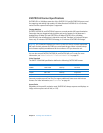
Chapter 3 Working with IMX 67
Transferring IMX Footage to Your Computer
IMX media is stored within MXF files, so the first step is to transfer the MXF files
containing your IMX media to your computer hard disk. Depending on the media
format you are using, you can use a Sony IMX VTR, XDCAM player, or any other device
that supports MXF file transfers. For more information about transferring IMX media to
your computer, see the documentation that came with your deck.
Importing MXF-Wrapped IMX Media Files into Your Project
Once you have MXF files on your hard disk, you need to extract the IMX MPEG-2 media
data and store it within QuickTime media files. This process requires a third-party
plug-in that extends the ability of Final Cut Pro to import MXF-encoded media. Once
your IMX media has been converted from MXF to QuickTime media files, you can
import the QuickTime media files into Final Cut Pro.
Choosing an IMX Easy Setup
After you convert MXF files to QuickTime media files containing IMX MPEG-2 media, you
need to choose a sequence preset (or corresponding Easy Setup) that is compatible with
your IMX format. Final Cut Pro includes Easy Setups for real-time editing using 30, 40, or
50 Mbps NTSC or PAL IMX media.
Editing IMX Clips into a Sequence
No special features or settings are necessary for editing IMX in Final Cut Pro. As with
any other format, you simply need to make sure your Easy Setup matches the format
of the footage you are editing.
Exporting IMX QuickTime Media Files
When you finish editing your sequence, you can export a QuickTime movie using the
corresponding NTSC or PAL IMX codec.


















